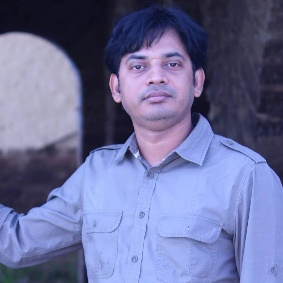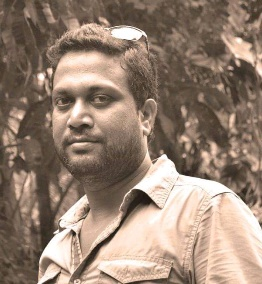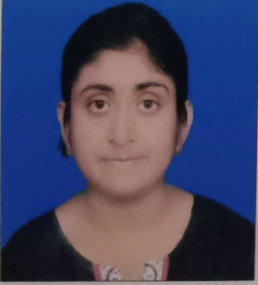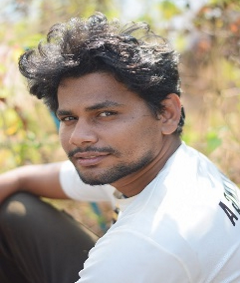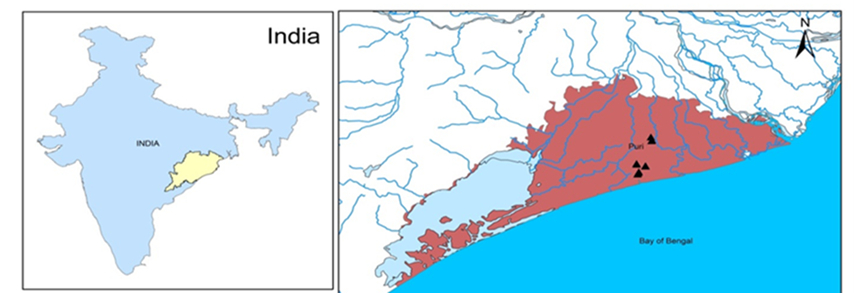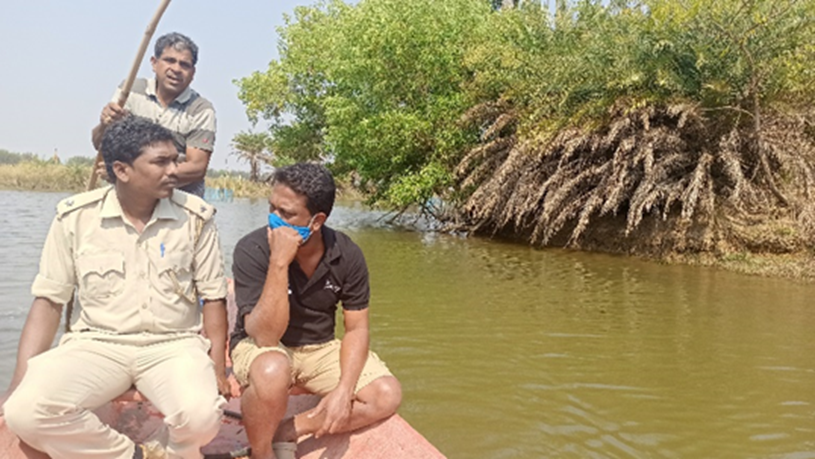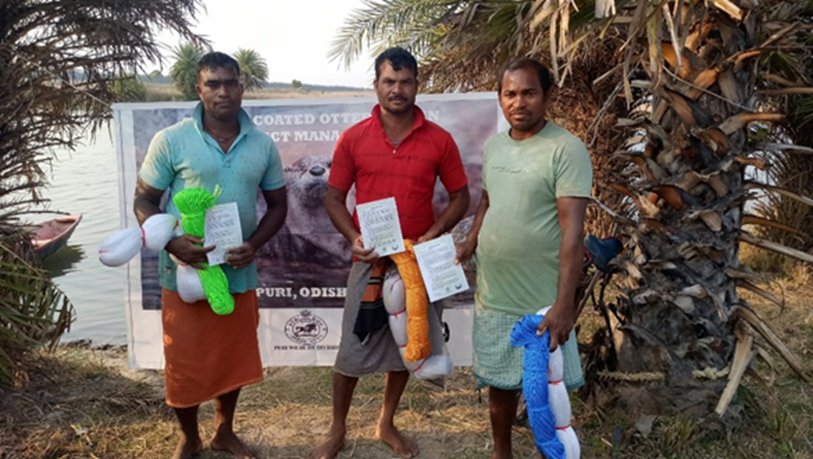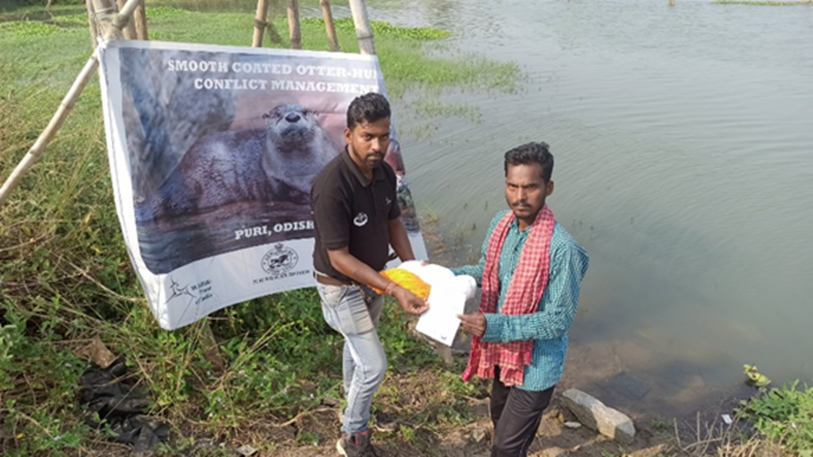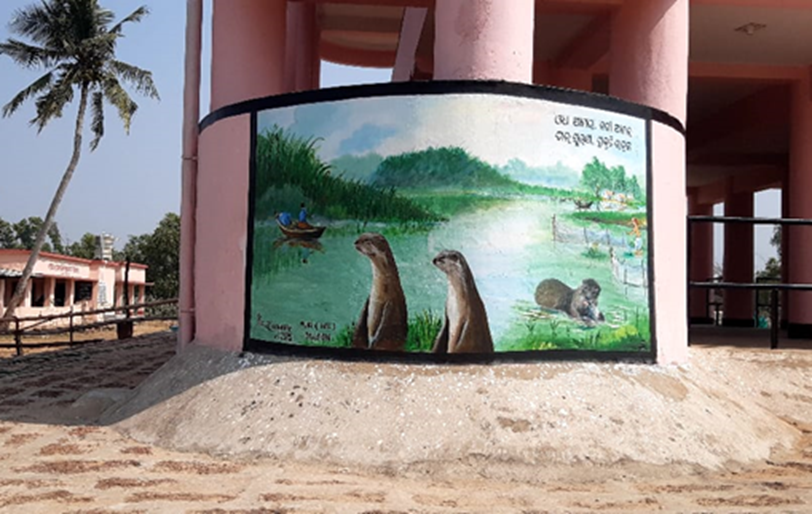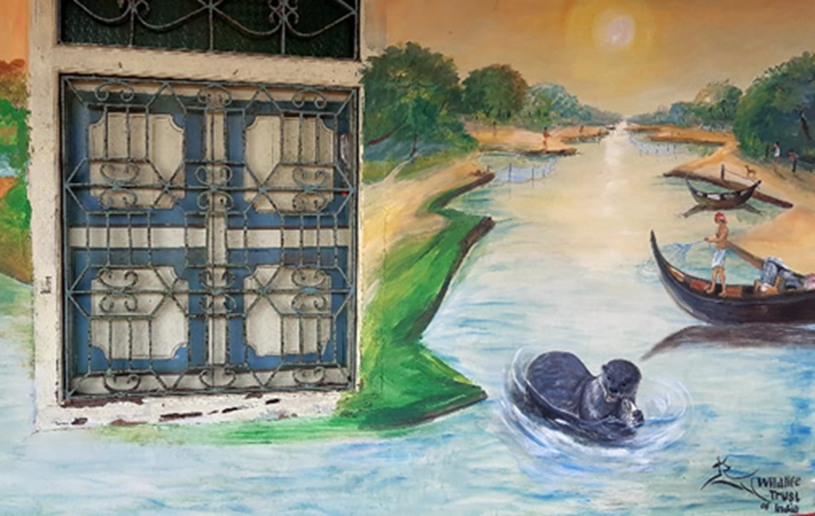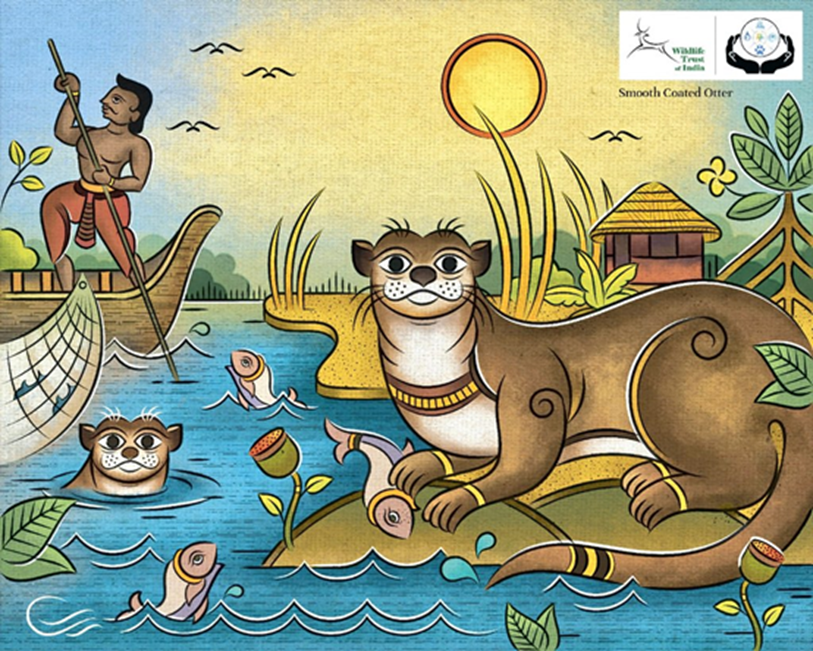IUCN/SSC Otter Specialist Group Bulletin

©IUCN/SCC Otter Specialist Group
Citation: Samal, A., Fullonton, S., Mahapatra, R., Rath, A., Pandey, S., and Jena, K.K. (2022). First Community-Based Conservation for Smooth-Coated Otters in Puri, Odisha, India. IUCN Otter Spec. Group Bull. 39 (2): 59 - 72
First Community-Based Conservation for Smooth-Coated Otters in Puri, Odisha, India
Aurobindo Samal,1,4*, Swarup Fullonton1, Rudra Mahapatra2, Akash Rath3, Shreya Pandey4, and Kalinga Keshari Jena4
1Earth Crusaders Organisation (ECO), Bhubaneswar, Odisha – 751019, India.
2Wildlife Trust of India, Bhubaneswar, Odisha – 751013, India.
3BiraHarekrushnapur, Malatipatpur, Puri Sadar, Odisha – 752008, India.
4Amity Institute of Forestry and Wildlife, Amity University, Noida, Uttar Pradesh – 201301, India.
*Corresponding Author Email: aurobindo.cse@gmail.com
(Received 16th September 2021, accepted 23rd November 2021)
Abstract: The presence of a species in a human-modified landscape often leads to conflict situations. Any loss to local communities poses a major threat to a species in its habitat. The Smooth-coated otter is an apex predator of aquatic ecosystems and often comes into direct interactions with local communities. Conservation can only be possible when communities are made aware of and are involved in conservation programs that safeguard wildlife and habitat. This conservation project is Odisha’s first community conservation project on Smooth-coated otters. For our study of Smooth-coated otters in Puri, Odisha, India, we approached local communities through social awareness campaigns in schools, government departmental sensitization, rapport building, wall paintings, fishing net compensation and local community workshops, believing that awareness is the major tool towards helping conservation programs.
Keywords: Social awareness campaign, rapport building, anthropogenic threats, fishing net, compensation program.
INTRODUCTION
In the present scenario of rapid human population growth, together with the high dynamism of changing environmental factors that result from human-implemented modifications of the ecosystem (Smith et al., 2018). The interaction of wildlife with humans often creates conflict situations and negatively affects the presence of the species.
Otters form a distinct group in the Mustelidae family of mammals and are placed in the Lutrinae subfamily (Sivasothi, 1995). Smooth-coated otters (Lutrogale perspicillata) are characterized by velvety, fine fur, and a shorter coat than the Small-clawed and Eurasian otters. Smooth-coated otter is listed as Vulnerable on the IUCN Red List, and is protected under Schedule II of Wildlife Protection Act 1972 of India. It is listed in Appendix I of CITES.
Protected areas comprise a small percentage of the landscape, and charismatic species are often the prime conservation focus in them.
A major role in the conservation of wildlife is played by communities. ‘conservation’ is often given meaning at odds with the cultural perspectives of the ‘communities’ that are expected to practice it. ‘Conservation’ covers a broad spectrum of management and benefit-sharing arrangements involving natural resource management by people who are not agents of the state but, by virtue of their location and activities, are critically placed to enhance or degrade the present and future status of natural resources. In a study of community approaches to wildlife management, IIED (1994) points out that the concept can be approached in spatial, socio-cultural and economic terms.
Economically communities can be considered as ‘groupings of people who share interests and control over particular resources’. Combining these one can derive a model of community as an entity socially bound by a common cultural identity, living within a defined spatial boundary and having a common economic interest in the resources of this area. The weight that people give to these different forms of value correlates closely with their cultural and socioeconomic location. For people in urban, industrial or post-industrial societies, wildlife has little direct economic significance (except for those employed in tourism or conservation) and emphasis is placed on its intrinsic or recreational worth. For rural peoples, for whom the presence of wildlife has important economic implications, wildlife valuations tend to be more instrumental, even where their cultures assign an intrinsic value to wildlife.
PROBLEM STATEMENT
After combining the analysis of people perception study results and our prior knowledge of the species we were able to define the problem statements of this project:
- Habitat degradation and fragmentation occurs because of human and agricultural settlements in otter habitat; people install fishing nets and block portions of the river for their livelihood, causing major changes to the habitat, including loss of suitable habitats and habitat degradation (e.g., deforestation, aquaculture industry, mangrove removal).
- Natural calamities and landform change are a major problem in this district, which is prone to cyclones, which cause landform changes such as destroying holts and foraging grounds.
- Retaliatory killing by the fishing community occurs when otters destroy fishing nets during foraging and they are killed in retaliation.
- Poaching, either for profit or ancient myths, for example the belief that suggests medicinal properties in otter blood, is highly detrimental to the species.
- Otters can be victimized by snares set for other species.
- Pesticide contamination of water bodies occurs near communities; since otters are primary fish-eaters, they consume contaminated fish.
- Over-fishing during off-seasons causes a reduction in prey base of otters.
The Impact of Natural Calamities on Smooth-coated Otters
Puri, Odisha (19.8135° N, 85.8312° E) (Fig. 1) has a long history of natural disasters, mainly due to a large number of cyclonic depressions that form each year in the Bay of Bengal. This sub-basin is highly active and produces some of the deadliest tornadoes of all time. Tropical cyclones form during the months of March to June and October to December with a peak in May and November. This has become a common scenario resulting in the natural habitat of many animals being lost. Wild animals during storms often run aground, die, or come into contact with humans, resulting in human-wildlife conflict. In Puri, for example, Cyclone FANI struck Balukhand Wildlife Sanctuary, near the Eco-sensitive Nuanai area in March 2019 (Figs. 2,3), forcing otters closer to human communities and leading to otter-human conflict.


STUDY AREA
River Nuanai is one of the major rivers of Odisha located near the Balukhand-Konark Wildlife Sanctuary, and flows through the District of Puri. This sanctuary is home to numerous wild flora and fauna. Nuanai is revered by local communities and highly modified for human use. The river flows through plantations, forest and paddy fields, as well as through agricultural fields flanking both sides of the river. We chose four places with both otter-human conflicts and riparian cover as our project sites, Chhaintana (Lat – 19.880112, Lon – 85.924844), Beladala (lat. 19.852205, Long. 85.90068), Ura (lat. 19.983282, long. 85.93503) and Antarkul villages (lat. 19.965642, long. 85.943455).
METHODS
The study was conducted from March, 2020 to February, 2021. In the three months of the first phase of the survey, we tried to build rapport with local community people.
A: Rapport Building
Building a trusting relationship with people is known as rapport building, an important step for local conservation efforts, particularly for good community participation, and enabling them to take pride in their conservation actions toward a species living alongside them. Good communication with researchers fosters better awareness of nature and encourages valuable input, even after the completion of the project.
Rapport building practices were implemented in communities across the study area (Fig. 4,5). We identified common ground that both researchers and villagers could agree on during our initial interactions with local communities. We made our intentions clear and explained to villagers the importance of otter conservation in their locality. In return, they were more than willing to participate in our activities. Understanding and body language helped garner support from the locals, as well as active listening, empathy, asking right questions and acknowledging what people say and experienced.
Because of rapport building in local communities, villagers participated in several conservation measures during this project. Apart from the several surveys conducted by our team, we depended upon information provided by locals about otter presence. With their help, we identified several threats to otters and conflict-prone locations for otters. Based on this information, we conducted awareness campaigns and anti-snare walks with the Forest Department. Rapport building with the fishing communities also helped us during our otter-human conflict mitigation program, in which we compensated fishers who had experience otter depredations with new fishing nets. Program activities like awareness campaigns in community centers and wall paintings were impossible without the support of the local communities.
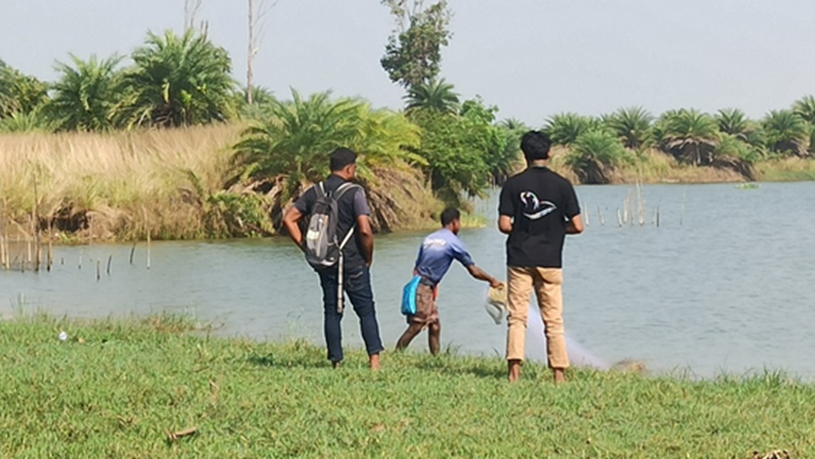
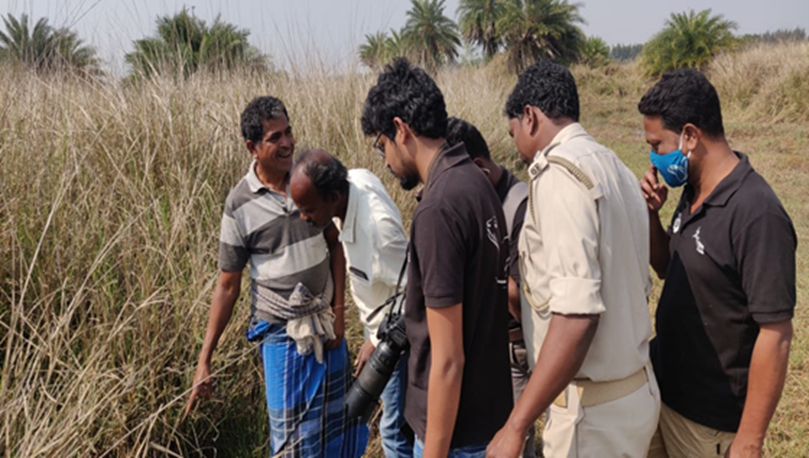
Social Awareness Campaigns
There is a lack of public awareness about the importance of local biodiversity and natural habitat conditions. Most local people are farmers and are poor and illiterate, and women are not allowed to work outside except on their own fields. Socioeconomic status in the communities is low.
In the second phase of the survey, we were more familiar with the study area and the condition of the habitat, and we recognized several ecological threats to otters. In this phase, we conducted education and awareness work (Fig. 6,7), by distributing pamphlets, banners, osters and conducting workshops in community centers, schools, and colleges. Issues like retaliatory killing, snaring, pollution and myths were addressed during these campaigns, which emphasized the importance of otters in the ecosystem and how to take pride in otter conservation.

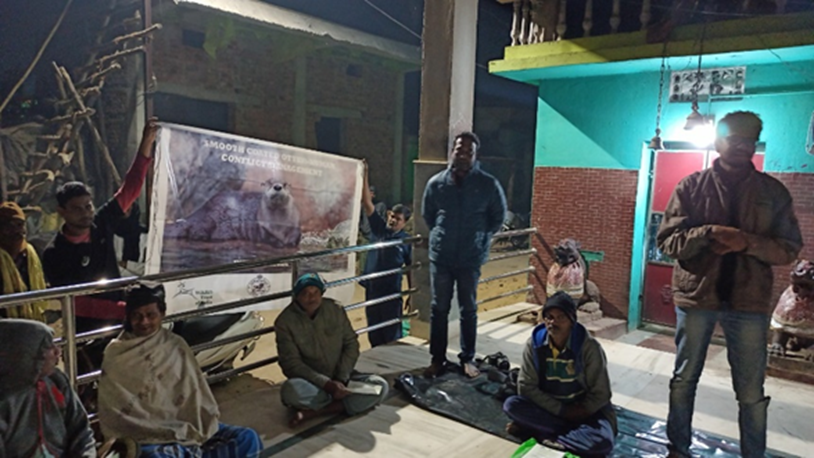
We also conducted awareness education in academies across the project site (Fig. 8,9). Students were taught the basics of conservation, keeping the future of otter conservation in the area in mind. Leaflets and banners were distributed and used respectfully. We we assisted by the Forest Department and tried to reach out to all age groups, including school children. The children are the future flag bearers and their valuation of wildlife is a major step towards a successful conservation program. Children are the major stakeholders of their habitat and can help to conserve it for a better future.
Sensitizing the Forest Department and Patrolling for Snare Removal
Extensive discussions were held with the Forest Department regarding the issues otters were facing. The Department is mainly focused on larger issues and often tend to ignore community-issues related to wildlife. Forest Department ranger are present on the ground day and night. Explaining the urgency of otter conservation through interactions and multiple walks were conducted for snare removal from otter habitat (Fig. 10,11).
Fishing Net Compensation
Mitigating negative impacts is an important conservation concern. Retaliatory killing of otters can endanger their populations, but prohibiting retaliation can anger communities sharing space with them (Madden, 2004; Woodroffe et al., 2005). Retaliatory killing by the fishing community occurs when otters destroy fishing nets during foraging. Most fishers in our project area use line nets and box nets for fishing, and nets remain submerged in the river for some time.
We wanted to mitigate this otter-fishing conflict, and decided to introduce fishing net compensation (Figs. 12,13). During our project, we compensated several fishers across our project site who lost their nets due to otter damage, improving their attitude toward the animals.
Wall Art
We believe that illustration amplifies the impact of conservation measures, as illustration engraves itself in hearts and minds. Illustration of otters on community centers educates people and inspires them to conserve the species. Wall art was valuable for community awareness and future care for otters (Fig. 14,15). The art is a constant reminder of the value of otters to the ecosystem and an encouragement to to the local conservation actions.
RESULTS
A post-project assessment was conducted between April and August, 2021. We reached out to the local people and assessed the major changes seen after the project. We had prioritized awareness-based conservation during the project, the first conservation project on otters in Odisha, and we wanted gauge community participation.
Querying the local communities led us to believe that local people are more aware of the presence and value of otters in their environment, and that they have a right to survive. The fishing community now understands the value of otters and they are learning to coexist with them. Students are now more curious about otter conservation and our project inspired the next generation. Otter conservation is a buzz among villagers due to our community awareness and wall painting initiatives. Snares were removed and present less of a threat. We sensitized the locals to the impacts of pesticide contamination of water bodies. The Forest Department is also sensitized and keeping an eye on illegal activities. A handbook on Smooth-coated otters was published to guide the Department in future conservation model plans on otters (Fig. 16).

CONCLUSION
Often the major problem for animals is direct conflict between humans and animals, including retaliatory killing. Perceptions of otters range from positive, when they act as tourist attractions capable of generating revenue, to neutral in agricultural landscapes, where they have no impact on local economies (Norris and Michalski, 2009), to negative where otters are perceived as competitors by fishers (Gómez and Jorgenson, 1999; Recharte et al., 2008). Although some studies report correlations between the magnitude of perceived or real damages (e.g. financial losses) and implementation of lethal control measures (Kloskowski, 2011), there is often considerable disparity between the actual damage by otters of net damage or prey consumption (Gómez and Jorgenson, 1999; Freitas et al., 2007; Recharte et al., 2008; Rosas-Ribeiro et al., 2011; Vaclavikova et al., 2011). Although the Smooth-coated otter is fairly tolerant of human presence (Shariff, 1984; Anoop & Hussain, 2004) fishing and gravel or sand extraction may play a major role in excluding otters from an area. This lability in human perceptions means that environmental education and awareness programs make it possible to modify human perceptions, and directly influence human behaviors with positive outcomes, such as reducing human wildlife conflicts and promoting biodiversity conservation (Dickman, 2010). Awareness programs in Puri became a major tool to change people’s mindset towards Smooth-coated otters, by promoting beneficial interactions between otters and local communities.
Acknowledgements: We thank to PCCF (WL), Odisha for providing all necessary permission for field activity. We thank to Wildlife Trust of India for their funding support to this project. We thank to RCCF, Bhubaneswar for their active and positive response to the project. We are thankful to DFO (Puri Wildlife Division), Balukhand Forest range office, Gop Range office and all the on-ground forest staffs for their cooperation. We are also thankful to Jungle Lore Foundation for logistic support.
REFERENCES
Anoop, K.R., Hussain, S.A. (2004). Factors affecting habitat selection by smooth-coated otters (Lutra perspicillata) in Kerala, India. J. Zool. 263: 417–423.
Chackaravarthy, SD, Kamalakannan, B and Lakshminarayanan, N (2019).The Necessity of Monitoring and Conservation of Smooth-Coated Otters (Lutrogale perspicillata) in Non-Perennial Rivers of South India. IUCN Otter Spec. Group Bull. 36 (2):83 – 87. https://www.iucnosgbull.org/Volume36/Chakaravarthy_et_al_2019.html
Dickman, A.J. (2010). Complexities of conflict: the importance of considering social factors for effectively resolving human–wildlife conflict. Animal Conservation, 13(5): 458-466. DOI: https://doi.org/10.1111/j.1469-1795.2010.00368.x
Freitas D, Gomes J, Sales-Luís T, Madruga L, Marques C, Baptista G, Rosalino LM, Antunes P, Santos R, Santos-Reis M (2007). Otters and fish farms in the Sado estuary: ecological and socioeconomic basis of a conflict. Hydrobiologia587:51–62 https://doi.org/10.1007/s10750-007-0693-7
Gómez, J. R. & Jorgenson, J.P (1999)An Overview of the Giant Otter-Fisherman Problem in the Orinoco Basin of Colombia IUCN Otter Spec. Group Bull. 16(2): 90 - 96
https://www.iucnosgbull.org/Volume16/Gomez_Jorgenson_1999.html
Holland, A.M., Schauber, E.M., Nielsen, C.K., Hellgren, E.C. (2019). River otter and mink occupancy dynamics in riparian systems. The Journal of Wildlife Management 83(7): 1552-1564.
I.I.E.D. (1994). Whose Eden? An Overview of Community Approaches to Wildlife Management. London, International Institute for Environment and Development. https://pubs.iied.org/8260iied
Kloskowski, J. (2011). Human–wildlife conflicts at pond fisheries in eastern Poland: perceptions and management of wildlife damage. European Journal of Wildlife Research 57 (2): 295-304DOI: https://doi.org/10.1007/s10344-010-0426-5
Kranz, A. (1994) Otters Increasing - Threats Increasing. IUCN Otter Spec. Group Bull. 10: 28 – 30
https://www.iucnosgbull.org/Volume10/Kranz_1994a.html
Lima, D., Marmontel, M. and Bernard, E.. (2014). Conflicts between humans and giant otters (Pteronura brasiliensis) in Amanã Reserve, Brazilian Amazonia. Ambiente & Sociedade 17: 127-142.
Madden, F (2004) Creating coexistence between humans and wildlife: global perspectives on local efforts to address human–wildlife conflict. Hum Dimens Wildl 9(4):247–257. https://doi.org/10.1080/10871200490505675
Mishra, SR, Mohan, M (2018). First Photographic Documentation and Distribution of the Asian Small-Clawed Otter Aonyx cinereus in Similipal Tiger Reserve, Odisha, India. IUCN Otter Spec. Group Bull. 35 (4): 186 - 192
https://www.iucnosgbull.org/Volume35/Mishra_et_al_2018.html
Norris, D. and Michalski, F. (2009). Are Otters an Effective Flagship for the Conservation of Riparian Corridors in an Amazon Deforestation Frontier?. IUCN Otter Spec. Group Bull. 26 (2): 73 – 77 https://www.iucnosgbull.org/Volume26/Norris_Michalski_2009.html
Recharte, M., Bowler, M. and Bodmer, R. (2008). Potential Conflict between Fishermen and Giant Otter (Pteronura brasiliensis) Populations by Fishermen in Response to Declining Stocks of Arowana Fish (Osteoglossum bicirrhosum) in Northeastern Peru. IUCN Otter Spec. Group Bull. 25 (2): 89 – 93 https://www.iucnosgbull.org/Volume25/Recharte_et_al_2008.html
Rheingantz, M.L., de Menezes J.F.S., de Thoisy, B. (2014). Defining Neotropical otter Lontra longicaudis distribution, conservation priorities and ecological frontiers. Tropical Conservation Science 7(2): 214-229.
Rosas-Ribeiro, P.F., Rosas, F.C.W., Zuanon, J. (2011).Conflict between fishermen and giant otters Pteronura brasiliensis in Western Brazilian Amazon..Biotropica, 44: 437-444 DOI: https://doi.org/10.1111/j.1744-7429.2011.00828.x
Shariff, S.M. (1984). Some observations on otters at Kuala Gula, Perak and National Park, Pahang. J. Wildl. Nat. Parks 3: 75 - 88.
Sivasothi, N., & Nor, B. H. (1994). A review of otters (Carnivora: Mustelidae: Lutrinae) in Malaysia and Singapore. Hydrobiologia 285, 151–1704). DOI: https://doi.org/10.1007/BF00005663
Smith CJ, Kramer RJ, Myhre G, Forster PM, Soden BJ, Andrews T, Boucher O, Faluvegi G, Fläschner D, Hodnebrog Ø, Kasoar M, Kharin V, Kirkevåg A, Lamarque JF, Mülmenstädt J, Olivié D, Richardson T, Samset BH, Shindell D, Stier P, Takemura T, Voulgarakis A, Watson-Parris D. (2018). Understanding Rapid Adjustments to Diverse Forcing Agents. Geophys Res Lett. 45(21): 12023-12031. DOI: https://doi.org/10.1029/2018GL079826
Woodroffe R, Thirgood S, Rabinowitz A (2005). People and wildlife—conflict or coexistence? Cambridge University Press, Cambridge. ISBN 9780511614774. DOI: https://doi.org/10.1017/CBO9780511614774
Václavíková M, Václavík T, Kostkan V. (2011). Otters vs. fishermen: Stakeholders’ perceptions of otter predation and damage compensation in the Czech Republic. J Nat Conserv, 19: 95–102. DOI: http://dx.doi.org/10.1016/j.jnc.2010.07.001
Résumé: Premiere Conservation Basee sur une Communaute Locale pour la Loutre à Pelage Lisse à Puri, Odisha, en Inde
La présence d’une espèce dans un paysage modifié par l’homme conduit souvent à des situations de conflit. Toute perte pour les communautés locales constitue une menace majeure pour une espèce dans son habitat. La loutre à pelage lisse est un prédateur au sommet des écosystèmes aquatiques et entre souvent en interaction directe avec les communautés locales. La conservation ne peut être possible que lorsque les communautés sont sensibilisées et impliquées dans des programmes de conservation qui protègent la faune et l’habitat. Ce projet de conservation est le premier projet de conservation communautaire d’Odisha sur les loutres à pelage lisse. Lors de notre étude des loutres à pelage lisse à Puri, Odisha, en Inde, nous avons approché des communautés locales grâce à des campagnes de sensibilisation sociale dans les écoles, une information des services départementaux, l’établissement de relations, les peintures murales, l’indemnisation des filets de pêche endommagés et des ateliers communautaires locaux, estimant que la sensibilisation est le principal outil pour aider les programmes de conservation.
Revenez au dessus
Resumen: Primer Caso de Conservación Basada en la Comunidad, para la Nutria Lisa, en Puri, Odisha, India
La presencia de una especie en un paisaje modificado por el ser humano, a menudo conduce a situaciones de conflicto. Cualquier pérdida de una comunidad local implica una gran amenaza para una especie en su hábitat. La Nutria Lisa es un predador tope de los ecosistemas acuáticos, y a menudo entra en interacciones directas con las comunidades locales. La conservación sólo puede ser posible cuando las comunidades conocen y se involucran en los programas de conservación que salvaguardan la fauna y el hábitat. Este proyecto de conservación es el primer proyecto comunitario de conservación de Nutrias Lisas de Odisha. Para nuestro estudio de las Nutrias Lisas en Puri, Odisha, India, nos acercamos a las comunidades locales a través de campañas de difusión y sensibilización en escuelas, sensibilización en departamentos gubernamentales, construcción de confianza, pintura de murales, compensación de redes de pesca, y talleres con la comunidad local, y creemos que la concientización y sensibilización son las principales herramientas de ayuda a los programas de conservación
Vuelva a la tapa


